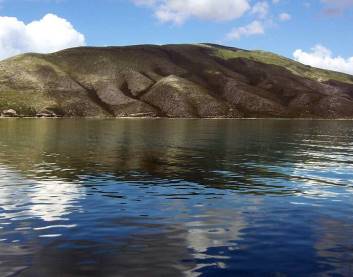

Location: Vlora region
Area: 12,428 hectares
Karaburun-Sazan National Park is located in the south-western
part of Albania in the Vlora region. It covers a total area of
12,428 hectares with a marine part of the Karaburun peninsula
equal to 9,849 hectares. In addition, the St. Basil Cape, Sazan
Island and the coastline 1.5 km inward belong to the sea area. This
national park received the status of a state marine park in April
2010.
The Karaburun-Sazan National Marine Reserve is rich in
numerous underwater landscapes inhabited by various species of
marine flora and fauna. The warm waters of the Adriatic Sea offer a
suitable environment for the growth of algae, sponges, mollusks,
crustaceans and even red coral. Another distinctive feature of the
biodiversity of this area are the underwater meadows of Poseidon (in
honor of the Greek god of the seas - Poseidon), what is considered
as a kind of environmental indicator of the Mediterranean, including
the nature and composition of the seabed, clarity of water and
transparency. Some of the largest marine mammals are the dolphins
and seals that frequent the area.
The Karaburun-Sazan
National Marine Reserve is open to the public. Especially there are
many divers in the summer season, although there are those who swim
here in the winter. In addition to natural beauty, you can explore
the remains of ancient Roman and Greek ships, as well as sunken
ships from the Second World War period. Most of the territory of the
Karaburun-Sazan National Marine Park is accessible only from the
sea, since they have very few roads leading to the park.
Karaburun-Sazan marine park is
distinguished by its diversity of habitats and its richness in flora
and fauna. Hundreds of species of mammals, birds, fish and reptiles
have been documented, many of which are endangered or threatened.
Almost 55 species of mammals, 105 species of birds, 28 species of
reptiles and 10 species of amphibians are known to breed in the
peninsula, while Sazan Island is inhabited by 15 species of mammals,
39 species of 'birds, 8 species of reptiles, 1 species of amphibian
as well as 122 species of invertebrates.
Karaburun-Sazan
park's varied landscapes, with considerable marine and terrestrial
life, free from all traces of human disturbance, retain a special
appeal. The park is home to an incredible variety of mammal species,
numbering over 70. The most common are the golden jackal, wildcat,
chamois, roe deer, wild boar, badger and otter. Smaller mammals
include the red squirrel, the hazel dormouse and the pine vole.
There are 8 species of bats found only in Sazan Island. Several of
them, such as Kuhl's and Nathusius's pipistrelle, are widespread and
common, while others, such as the Mediterranean long-eared bat, are
relatively rare and their distribution is limited. The biodiversity
of local oceanic fauna is not well known. Sea turtles, seals and
dolphins are considered to reside in the park area. Three main
species of sea turtles are found along the park's beaches such as
the loggerhead sea turtle, green turtle, and leatherback turtle.
Dolphins like the short-beaked common dolphin, bottlenose dolphin
and sperm whale have been reported in the waters of the park.
Exceptional is the presence of the Mediterranean monk seal, one of
the most endangered mammals in the world, which mainly takes refuge
in the inaccessible caves and canyons of the park.
Karaburun-Sazan marine area is characterized by an exceptionally
rich and varied flora. The coasts along Karaburun and Sazan are
rocky with significant limestone cliffs, covered with Mediterranean
scrub with a dominance of mastic, kermes oak and Phenician juniper.
The western coasts are incised by caves and canyons and
characterized by high vertical cliffs that appear underwater at
great depths. The cliffs are mainly dotted with sea fennel, statice
and caper. The macrofauna includes sponges, cnidarias, bryozoas,
molluscs and many others.
The most notable feature of Sazan Island is its unique climate. Its climate is not Mediterranean but rather subtropical due to its warm winters and hot summers, resembling those of southern Crete, Tunisia and Egypt.